
How to look for records of... Land and property for charitable use: trust deeds, 1736-1963
How can I view the records covered in this guide?
How many are online?
- None
Contents
- 1. Why use this guide?
- 2. Understanding charitable status and trust deeds
- 3. Legislative background to the records
- 4. An introduction to the records and how to see them
- 5. Searching for trust deeds from 1736-1905
- 6. Searching for trust deeds from 1906-1925
- 7. Searching for trust deeds from 1926-1963
- 8. Searching for trust deeds for schools and other educational purposes in Ministry of Education files, 1903-1960
1. Why use this guide?
This is a guide to trust deed documents, held at The National Archives, which recorded the conveyance of land and property for some kind of charitable purpose between 1736 and 1963.
Many of these documents record the acquisition of land and property by churches but cover institutions and landholdings of various other kinds, including:
- schools
- hospitals
- almshouses
- museums
- public parks
Reflecting the proliferation of charitable organizations and philanthropic activity in England and Wales from the mid-18th century onwards, often in the cause of improving conditions for people living in poverty, the records can help to establish:
- when an institution was founded
- when an institution acquired a piece of land or property
- who the benefactors of a charity or charitable institution were
- who maintained and managed an institution
- what the land or property was used for (or what it was intended to be used for)
- other insights into the history, character and purpose of an institution or place
For advice on locating records dating from more recent decades you should contact the Charity Commission. However, the Charity Commission’s own records are mainly case files recording their interactions with charities, not the records of the charities themselves. Trustees are responsible for maintaining their charity’s records and your first port of call for records of an existing institution should be the charity itself. A number of charities have transferred archival records to local metropolitan and county record offices.
2. Understanding charitable status and trust deeds
Schools, hospitals, churches and other institutions could and still can be granted charitable status if their purpose is deemed to be for the public benefit. Their role could be educational, religious, to alleviate poverty or some other endeavour for the general good of society.
A trust is a legal arrangement in which an asset of some kind is put in the possession of a trustee (or trustees) to be held for the benefit of another. For example, the Wellcome Trust, established in 1936, was set up to manage endowments left by Sir Henry Wellcome for the benefit of human and animal health through biomedical research. A trust deed is the legal document that records the conditions of the trust, therefore generally recording the transference of land, property or other assets from one person to another (a conveyance).
Today trust deeds (sometimes referred to as declarations of trust) are not registered with the courts but from 1736 until 1925 most deeds relating to transfers of land for charitable purposes had to be registered, or ‘enrolled’, at the Court of Chancery, and latterly with the Supreme Court. From 1856 they could also, voluntarily, be enrolled with the Charity Commission.
3. Legislative background to the records
Following the Mortmain and Charitable Uses Act 1736, conveyances of lands, goods and money in trust for charitable purposes had to be formally drawn up and properly witnessed. They then had to be enrolled within six months, often with a plan of the property, with the Court of Chancery.
The Charitable Trusts Amendment Act 1855 established that any deed, will or other document relating to charities could also be voluntarily enrolled in the books of the Charity Commissioners.
Following the Mortmain and Charitable Uses Act 1888, elementary school masters’ houses (up to one acre), public parks (up to 20 acres) and public museums (up to two acres) could also be enrolled in the Charity Commissioners books instead of Chancery. Also gifts of land under the Working Class Dwellings Act 1890 and the Technical and Industrial Institutions Act 1892 could be similarly enrolled.
From 1926, under the Settled Lands Act of 1925 (15 & 16 Geo V c 18), it was a requirement to enrol all land vested for charitable purposes with the Charity Commission.
The Education Act of 1944 (7 & 8 Geo VI c 31) stipulated that all trust deeds for educational purposes were required to be recorded with the Minister of Education. This provision was repealed in 1960.
4. An introduction to the records and how to see them
These records are not available to view online. To see them you will need to visit us at our building in Kew unless you can find a document reference online in which case you can order a copy to be sent to you. However, most of the key resources you will need to find individual document references in the first place are only available at Kew – they are described in detail in the subsequent sections of this guide.
Where we would nowadays talk of ‘registering’ a deed or document, in the language of the courts and government bodies concerned here the deeds were ‘enrolled’. Deeds were recorded on pieces of parchment, or ‘membranes’, and the pieces sewn together and then rolled together for storage. We therefore refer to ‘rolls’ and, later, even after the process had been modernised, to ‘enrolment books’.
The key record series, with their series references, are:
- C 54 for Chancery enrolments up to 1903
- J 18 for Supreme Court enrolments from 1903
- CHAR 12 for Charity Commission enrolments from 1856 to 1925
- CHAR 13 for Charity Commission enrolments from 1926
Although enrolments only start in 1736, it seems that trustees of many existing charities chose to enrol earlier deeds.
5. Searching for trust deeds from 1736-1905
For enrolments at the Court of Chancery, in C 54, and the Supreme Court, in J 18, you can find a trust deed using the indexes in the Map and Large Document reading room at Kew. The indexes allow you to search for deeds from this period with nothing more than a place name.
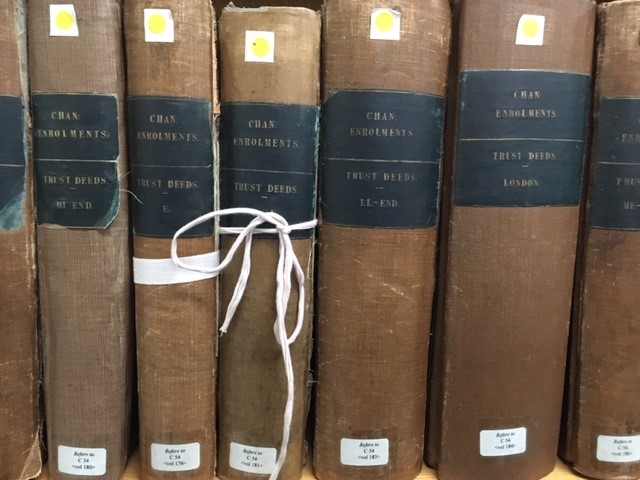
The indexes to trust deeds up to 1870, held in series C 54. These indexes are held in the reading rooms of The National Archives at Kew.
5.1 Searching for a deed by place, 1736-1870: trust deed indexes to C 54
The indexes for this period consist of several dozen bound volumes arranged alphabetically by place. There is a separate volume for London (in which places correspond to the old pre-1965 London County Council area).
Some entries, such as the one for Higham within the Forest of Pendle below, provide references in regnal years (52 Geo. III). You can use online convertors (or the printed C 54 series list, also available in the reading rooms) to convert regnal years to calendar years. The number after the year indicates the close roll number for the year in which the deed of trust was enrolled and the final number indicates the item on the roll itself.
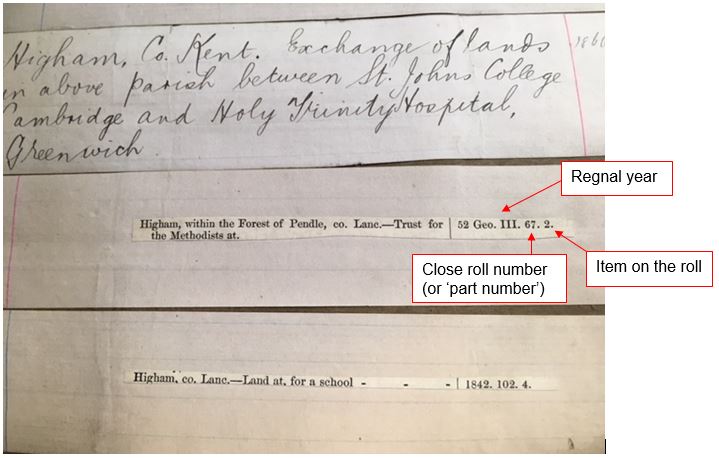
The index entry for Higham within the Forest of Pendle (in the county of Lancashire) indicates that the deed was enrolled in close roll no.67 for 1812 (the 52nd year of George III’s reign) and that the enrolled deed will be numbered as item 2 on the roll itself.
To get from an index entry to the record itself, follow these steps (alternatively consult the printed C 54 series list in our reading rooms):
- Step 1: Go to the C 54 catalogue description
- Step 2: Using the ‘Keyword search’ tool, search with the close roll number (referred to in the catalogue as the ‘part number’), and the year (in the date range boxes)
- Step 3: Your search results should include at least one catalogue description for that ‘part’ and that year – if there is more than one then you may need to look at both
- Step 4: Order the document and find the item number on the roll itself
5.2 Searching for a deed by place, 1870-1905: trust deed indexes to C 54 and J 18
To locate a trust deed by place for the years between 1870 and 1905 use the card index held in a chest of drawers in the Map and Large Document reading room at Kew.
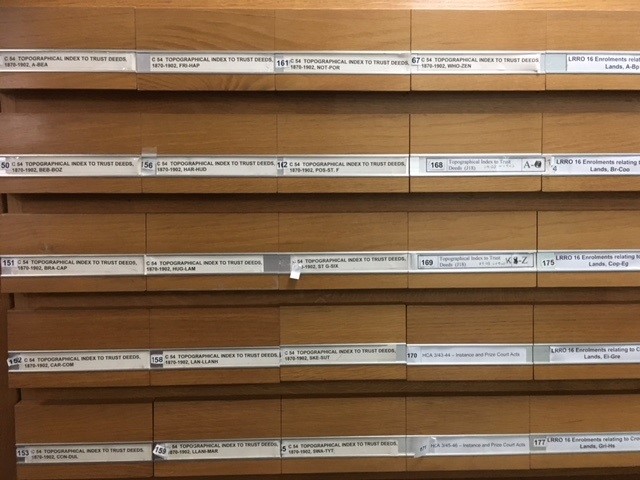
Trust deeds 1870-1905 – the card index in our reading rooms.
Arranged alphabetically by place, each index card provides the year of enrolment, the roll number (or ‘part’ number), the item number and the full C 54 or J 18 reference.
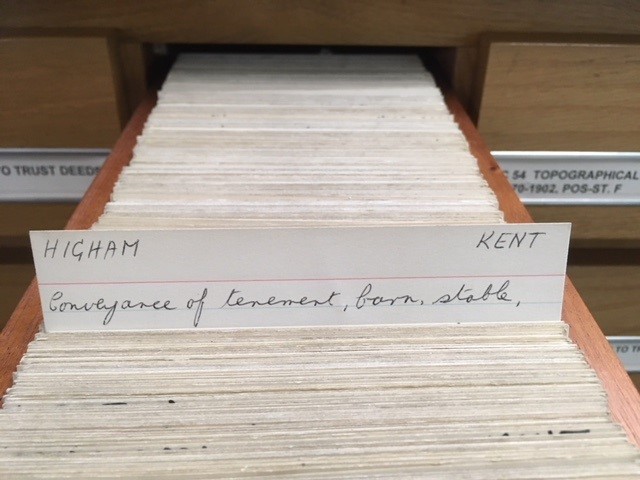
Trust deeds 1870-1905 – use the index cards to locate a trust deed by place.
Locate the reference in our catalogue from where you can order the document. You will find the item number on the roll itself.
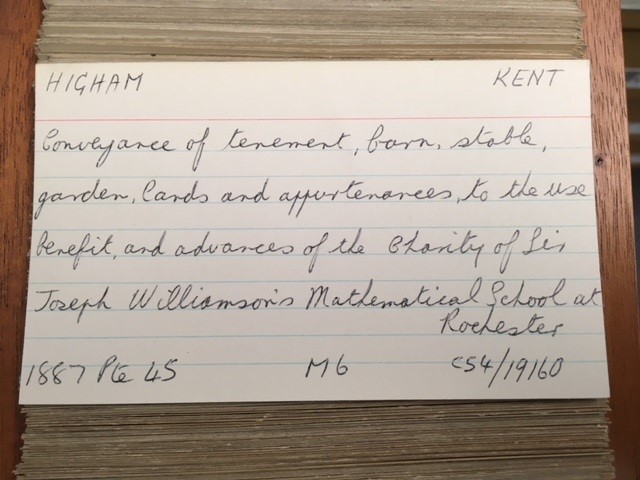
Trust deeds 1870-1905 – the index card provides the full document reference – in this instance it’s C 54/19160.
5.3 Alternatives to the trust deed indexes
If you are looking for a deed which is not mentioned in the trust deed indexes, it may be worth checking in the general indexes to deeds enrolled in Chancery, listed in our research guide on Land and property ownership: enrolment and registration of title 1227-c1930.
For trust deeds dating between 1856 and 1925 you may also want to check the enrolments with the Charity Commission by browsing through CHAR 12. As catalogue descriptions for CHAR 12 are terse, you will have to select enrolment books based solely on the enrolment dates covered by each volume.
6. Searching for trust deeds from 1906-1925
For 1906-1925, Supreme Court enrolment books are in J 18. There are yearly indexes to these title deeds, arranged chronologically by the initial letter of the name of the grantor – the index references also often give a place and county (but are not arranged by place). They are in volumes held in the Map and Large Document Reading Room at Kew. If you do not know the name of the grantor and you are trying to find a trust deed of a Church of England school, the Church of England Record Centre may be able to provide this information.
You may also want to check the Charity Commission enrolments in CHAR 12. You will need to browse the series and select from the thirteen volumes according to year ranges as there are no indexes and catalogue descriptions are otherwise unrevealing.
7. Searching for trust deeds from 1926-1963
From 1926, land vested for charitable purposes was enrolled either with the Charity Commission or the Supreme Court.
The Charity Commission enrolment books are in CHAR 13. There is a place name index to the books available on microfilm in the reading rooms at The National Archives in Kew. The index provides a two part reference – for example, 1365/59. The first number (1365) is the enrolment number and the second number (59) is the volume number. The volume number is the same as the piece number so to order a volume simply go to our catalogue and search for CHAR 13/[volume number] – in this example you would search for CHAR 13/59.
The post-1925 Supreme Court enrolment books, like the pre-1925 books are in J 18 and are indexed by grantor (as described in section 6 above).
8. Searching for trust deeds for schools and other educational purposes in Ministry of Education files, 1903-1960
The Education Act of 1944 stipulated that all trust deeds for educational purposes should be recorded with the Ministry of Education. This provision was repealed in 1960.
Search by county or name of school in the Public Elementary School Files, in ED 21, for trust deeds for educational purposes, many prior to 1944. This series contains a wide variety of records – not just trust deeds.
Search in ED 191 for deeds, mostly relating to elementary schools, dating from 1903 to 1920.